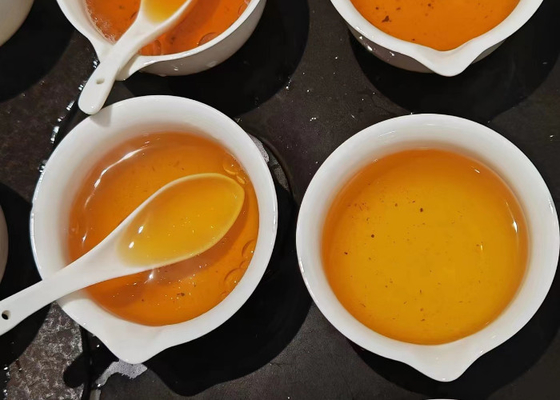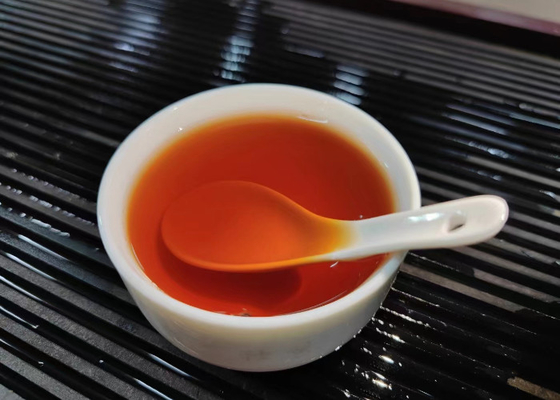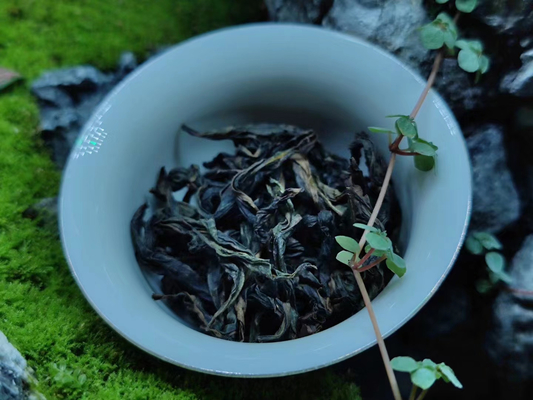Jin Junmei 80g canned gift box tea wuyi mountain flower small seed lianyun tea factory wholesale
Product Details:
| Place of Origin: | wuyishan |
| Brand Name: | lianyun |
| Certification: | ISO |
|
Detail Information |
Product Description
Jin Junmei 80g canned gift box tea wuyi mountain flower small seed lianyun tea factory wholesale
Product definition
Jinjunmei tea, a branch of black tea in Zhengshan, originated from Tongmu Village, Wuyishan City, Fujian Province. Led by jiang Yuanxun, the 24th generation inheritor of Lapsang Souchong Black tea, the team developed a new black tea in 2005 based on the traditional technology through innovation and integration. [1-2]
The reason why Jinjunmei is so valuable is that the whole process is handmade by tea makers. Every 500g jinjunmei needs tens of thousands of fresh tea buds, which are harvested from the original alpine species in Wuyi Mountain Nature Reserve and processed through a series of complicated processing steps, such as wire-wilting, shaking green, fermentation, rolling and so on. Jin Junmei is a rare treasure of tea, small and compact in shape, accompanied by golden velvet tea, golden color of the soup sweet entrance.
Product Description:
Cultivation characteristics, origin of name, distribution of place, production environment,
Eyebrow Mr. Jin
Jinjunmei root system is not developed, root injury is not easy to heal, drought resistance, cold resistance. Its fibrous roots are few, and the transverse distribution is more, the longitudinal distribution is not deep. Weeding and ploughing are too deep and too close to damage their roots and cause dead seedlings. When transplanting, the soil is not pressed or the root water is not enough, or after transplanting, high temperature and drought, not timely irrigation will also die seedlings.
Jinjunmei has a strong advantage at the top, so it is necessary to push the branch to grow more new buds and leaves in time to improve the yield.
Jin Jun eyebrow buds more, more results. A large number of flowers and fruits will consume nutrients and must be removed in time, otherwise the buds and leaves will grow slowly, put into production late and yield is low.
Poor adaptability. Jinjunmei has high requirements on soil, and can grow well only in thick clay soil.
Cover drought-resistant seedlings. Newly planted tea seedlings, poor resistance, both afraid of dry and afraid of sun. Straw can cover the whole garden, the thickness of 5 cm; Or covered with mushroom soil, can reduce soil surface temperature, maintain soil moisture, inhibit weed growth, and can increase soil organic matter, improve soil physical and chemical properties. At the same time, do a good job of water management, to meet the water demand of tea plants
Fill the gaps with seedlings in time
The survival rate of Jinjunmei is low, so it is necessary to do a good job of seedling inspection and seedling replacement, leaving 2 plants at each hole.
Thin flower thinning
When tea seedlings appear buds, to be removed in time to reduce nutrient consumption.
Reasonable fertilization
Before colonization, foot bottom fertilizer can be applied 4-5 times a year, applied in each round of new bud germination, each application of 5-10 kg compound fertilizer, 3-5 kg urea, 15 cm from the root ditch or hole application, and covered with soil. The bottom fertilizer is insufficient, should take organic fertilizer and chemical fertilizer with application, in the winter of each year combined with shallow tillage sufficient base fertilizer, mu fertilizer 1000 kilograms.
Hoe weeding
The root distribution of Jinjunmei is relatively shallow. In order to avoid root injury, artificial weeding can be used, and weeds can be covered on the edge of tea seedlings. Meanwhile, it is not often ploughed.
The plastic clip
The use of top generation shear stereotyping, that is, in the tea seedling colonization before leaving the stem 20 cm high cut off the upper part. After the spring tea grows, the top tip and the long side tip which are more than 25cm away from the soil surface are picked. After the germination of the new shoots in each round, the top tip is raised 5-8cm on the original basis. The annual canopy can be raised by about 20-25 cm.
Prevention and control of diseases and pests
Check the tea garden and prevent diseases and insect pests in time. Choose biopesticides or pesticides with high efficiency, low toxicity and low residue, strictly control the dosage, and strictly observe the harvest safety interval. [8]
1.1.1 Origin of Name
After brewing, the tea is amber and golden, with a light and sweet honey fragrance, sweet and lubricated, and the buds at the bottom of the leaves are straight and straight, showing a fresh bronze color. [5]
1. Gold: Jinjunmei is made of spring buds, picked once a year, and only the raw materials of tea trees in Wuyishan National Nature Reserve can be made with the unique quality of authentic Jinjunmei. It is as rare as gold, indicating that it is a top black tea, so it is named "Gold".
2. Jun: Because its raw materials are picked from wild tea trees in the mountains of Tongmu Village Nature Reserve, and it is hoped that this tea can be promoted as quickly as galloping horses, so it is named "Jun".
Three, eyebrow: the traditional famous tea has the name "eyebrow", Jin Jun mei to tea bud this raw material, tea slender as eyebrow, "eyebrow" and long, longevity meaning, so named "eyebrow" word; After thinking through, it was named "Zhengshan Hall" Jin Junmei. [1-2]
1.1.2 Distribution of origin
Eyebrow Mr. Jin, the birthplace of raw material harvest in black tea, the world natural and cultural heritage sites, wuyi mountain national nature reserve in 565 sq km of the original high camellia buds, paulownia village is located in the heartland of wuyi mountain national nature reserve, paulownia village is famous for "tea", it is the birthplace of the "world black tea". [6]
1.1.3 Growth environment
Tongmuguan has a high terrain and 96.3% forest coverage rate. The average altitude of the main tea producing areas is about 1200 meters. The annual average fog day is 120 days, the annual average temperature is 11-18℃, the annual average precipitation is about 2000 mm, the average humidity is 80%, the soil PH value is 4.5-5, and the soil thickness is 30-90 cm. Belongs to the typical subtropical monsoon climate. Here is the ecological environment of the growth of golden junmei
Quality characteristics, processing technology, main varieties, value function
Eyebrow Mr. Jin
Jin Jun eyebrow appearance is small and tight show. The color is gold, yellow and black. Golden for tea villi, buds, cable tight knot slender, round and straight, front seedlings, body bone weight, uniform. Open soup golden color, the water with sweet, sweet through incense, the cup at the end of the flower fruit fragrance can not imitate and beyond the rare quality. Special aroma, dry tea fragrance fragrance; Hot soup smell fresh and pure; Warm soup (about 45℃) ripe and delicate; Cold tang qing and elegant, qing gao lasting. Both hot and cold drinks are soft and smooth, with the characteristics of "clean, smooth, mellow, thick and fragrant". After soaking 12 times, the taste is still full and sweet. After the leaf base stretches, the bud tip is fresh and beautiful.
The processing technology
1.1.1 Picking Standards In the picking season, tea leaves withering, shaking and fermentation,
The picking of Jin Jun Mei tea requires taking fresh tea buds and picking the freshest part of bud head. The picking standard is: when the new shoots of tea trees grow to 3-5 leaves are about to mature, and 2-4 leaves are picked when the parietal leaves are 60-70% open, commonly known as "open surface picking". So-called "open face pick", divide again for small open face, in open face and big open face, small open face is new tip top the area of a leaf is equivalent to 1/2 of the second leaf, in open face is new tip top the area of the first leaf is equivalent to 2/3 of the second leaf, the area of big open face new tip parietal leaf is equivalent to the area of the second leaf.
1.1.2 Picking season
Different tea leaves are divided into spring tea, summer tea, autumn tea and winter tea according to different picking seasons. Although tea trees grow for a long time, winter tea is generally not picked. Spring tea is picked around grain rain, summer tea around summer solstice, and autumn tea around autumn equinox. Picking should follow the principle of "starting early, middle net just right, and late stage not coarse and old". [9]
1.1.3 Tea withering
Sun withering
Jin Junmei uses light energy heat to make fresh leaves moderately lose water and promote the activation of enzymes, which plays an important role in forming the aroma of Jin Junmei tea and removing the odor, and also creates good conditions for shaking green tea. Sunning temperature requires soft sunlight and leaves are thin. When necessary, "two cooling and two drying" can be done for 10 minutes to 1 hour. During this time, stir 2-3 times. Sunburn degree, generally to lose luster, leaf color to dark green, sagging parietal leaf, stem bending and continuous, hand hold a sense of elasticity. After the sun to green again, so that its fresh leaves "sun". [9]
Indoor the withering
The back of the jin Jun mei fresh leaf booth on jia li, static in the cool green rack, as appropriate to turn 2-3 times to withering uniform, Min Qing generally not alone, combined with sun green, its main role: one is to send out leaf moisture and leaf temperature, so that the tea "live" to maintain freshness; Second, it can adjust the sun time, delay the speed of sun water evaporation, easy to shake green in a day is insufficient sun green fresh leaves, but also a remedy method. The moderation of cool green is: the tender stem is green and full of water, and the leaves are fresh and without water [9].
1.1.4 Shaking and fermentation
Jinjunmei tea leaves chafe the leaf edge cells through the friction movement in the shaking machine, so as to promote enzymatic oxidation and make a series of biochemical changes in fresh leaves. 1 Shake green time: shake, cool (i.e. dynamic, static) repeated 4-5 times, lasting 8-10 hours, so that the leaves from hard to soft (" live to die "), grain is called "xiaoqing", which reaches "green leaves red edge".
Shake green principles
Jinjun eyebrow shake green to master the "step by step" principle. Shake green speed by small gradually more, light gradually born, spread leaves by thin gradually thick, time by short gradually long, fermentation by shi gradually heavy. 3 shake green "five see" a look at varieties shake green: leaves shake, thin leaves shake gently, two look at the season shake green: spring tea low temperature, high humidity, suitable for heavy shake. Summer tea temperature is high, should shake gently. Autumn and winter tea requirements to achieve "sanqiu" that is, autumn color, autumn taste, suitable for light shaking. In short, shake green to do is "spring tea elimination, summer wrinkle, autumn tea guard". Three look at the climate shake green: south wind, light shake, north wind, heavy shake. Four see fresh leaves old and tender shake green: fresh leaves tender, moisture, less shake fresh leaves thick and old, fresh leaves thick and old, more shake in light sun. Five see the degree of tanning, tanning light heavy shake, tanning heavy light shake. (1) Touch: touch whether the fresh leaves are soft and have a wet feel; (2) look: see whether the leaf color from green light to dark green, leaf surface appears red dots; (3) Smell: Whether the smell of green gas subside, aroma exposure. [9]
1.1.5 Finalized
Eyebrow is ensured in indoor quiet place with Mr. Jin stirring, until the grass lost (smell), photoluminescence, and fragrance micro, Yang and tea division into fermentation moderate issued after the filming for the filming for the can prepare (or called liquor), the purpose of in high humidity to destroy the activity of the enzyme, inhibition of tea to continue fermentation, in order to avoid to keep the temperature completely lost and semi-fermented tea kind of peculiar smell.
At the same time, because of the evaporation of water in the leaves, the leaves become soft, which is conducive to rolling molding and dry treatment. The time of coarse green must be controlled precisely. The tea should be thoroughly fried. If the tea is cooked too early and the tea is not fully ripe, the tea will have a grassy green taste. [9]
1.1.6 Rolling processing
After 5-8 minutes of continuous rolling, make the leaf roll into a rope, break the leaf cells, squeeze out the juice, adhere to the leaf surface, soluble in water when washed, increase the concentration of Jinjunmei tea soup. Rolling master "while hot, right amount, fast, short time" principle of pressure to "light, heavy, light" speed control "slow, fast, slow. [9] Shake green all
Quality characteristics, processing technology, main varieties, value function
Eyebrow Mr. Jin
Jin Jun eyebrow appearance is small and tight show. The color is gold, yellow and black. Golden for tea villi, buds, cable tight knot slender, round and straight, front seedlings, body bone weight, uniform. Open soup golden color, the water with sweet, sweet through incense, the cup at the end of the flower fruit fragrance can not imitate and beyond the rare quality. Special aroma, dry tea fragrance fragrance; Hot soup smell fresh and pure; Warm soup (about 45℃) ripe and delicate; Cold tang qing and elegant, qing gao lasting. Both hot and cold drinks are soft and smooth, with the characteristics of "clean, smooth, mellow, thick and fragrant". After soaking 12 times, the taste is still full and sweet. After the leaf base stretches, the bud tip is fresh and beautiful.








